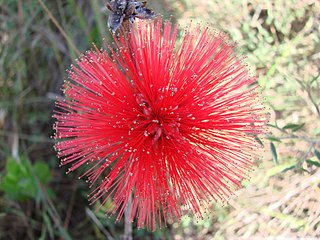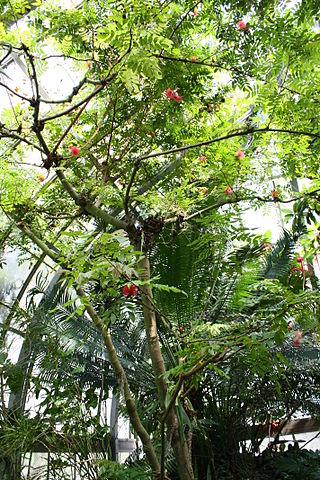
Calliandra is a genus of flowering plants in the pea family, Fabaceae, in the mimosoid clade of the subfamily Caesalpinioideae. It contains about 140 species that are native to tropical and subtropical regions of the Americas.

Calliandra eriophylla, commonly known as fairy duster, is a low spreading shrub which is native to deserts and arid grasslands in California, Arizona, New Mexico, Texas, and Mexico.

The copper sunbird is a species of passerine bird in the family Nectariniidae. It is native to tropical Africa, its range extending from Senegal and Guinea in the west to South Sudan and Kenya in the east, and southwards to Angola, Zambia, Zimbabwe and Mozambique.
Oxanthera brevipes is a species of plant in the family Rutaceae. It is endemic to New Caledonia. It was proposed as a novel species by Benjamin C. Stone based on two specimens, distinguished from other false oranges by a non-articulated petiole. The genus Oxanthera has been synonymized with Citrus, but a name in Citrus does not appear to have been published, and Plants of the World Online regards "Oxanthera brevipes" as an unplaced name.
Vatica brevipes is a tree in the family Dipterocarpaceae, native to Borneo. The specific epithet brevipes means "short foot", referring to the petiole.

Calliandra californica, the Baja fairy duster, is an evergreen, woody shrub, native to Baja California, Mexico. In Spanish, the plant is also known vernacularly as tabardillo,zapotillo or chuparosa. The flowers, which appear in early summer, have clusters of red stamens. The shrub is usually 0.6–1.8 metres in height and has bipinnate leaves. The leaves have been described as "fern-like." Leaves close at night time.

Malus brevipes, with the common name shrub apple, is a species of crabapple in the genus Malus, in the family Rosaceae.
Calliandra bella is a species of flowering plants of the genus Calliandra in family Fabaceae. It is a shrub or small tree and is endemic to forests of the Bahia coast in Brazil.

Calliandra chilensis is a species of flowering plants of the genus Calliandra in the family Fabaceae.
Calliandra conferta is a species of flowering plants of the genus Calliandra in the family Fabaceae.
Calliandra cruegeri is a species of flowering plants of the genus Calliandra in the family Fabaceae.

Calliandra dysantha is a species of flowering plants of the genus Calliandra in the family Fabaceae. Is native to Brazil.

Calliandra haematocephala is a species of flowering plants of the genus Calliandra in the family Fabaceae.
Calliandra haematomma is a species of flowering plants of the genus Calliandra in the family Fabaceae. Calliandra pilosa is a synonym of C. haematomma var. glabrata.
Calliandra peninsularis is a species of flowering plants of the genus Calliandra in the family Fabaceae. It is endemic to Baja California Sur state in Mexico.

Calliandra purpurea, the soldierwood, is a species of flowering plants of the genus Calliandra in the family Fabaceae.

Calliandra riparia is a species of flowering plants of the genus Calliandra in the family Fabaceae. It is native to Panama, Colombia, Guyana, and Venezuela

Calliandra surinamensis is a low branching evergreen tropical shrub that is named after Suriname, a country in northern South America. The plant usually has complexly branched multiple trunks and grows to a height of about 5 metres, although many sources suggest that it only attains a height of 3 metres. Left unpruned it grows long thin branches that eventually droop down onto the ground. The leaves close and droop from dusk until morning when they once again reopen. Calliandra surinamensis is said to contain lectins which are toxic to cancer cells, although more research is needed. Calliandra surinamensis contains three important compounds: myrectin which contains antioxidant and anti-inflammatory properties, lupeol which contains anti-inflammatory and anti-cancer properties, and ferulic acid which contains antimicrobial properties.

Calliandra calothyrsus is a small leguminous tree or large shrub in the family Fabaceae. It is native to the tropics of Central America where its typical habitat is wet tropical forests or seasonally dry forests with a dry season of four to seven months, when it may become deciduous. This tree grows to about 6 m (20 ft) and has pinnate compound leaves and flowers with a boss of prominent reddish-purple stamens. It is not very drought-tolerant, and the above-ground parts can be short-lived in case of severe drought lasting many months, but the roots regularly resprout.














